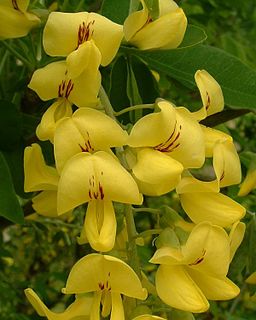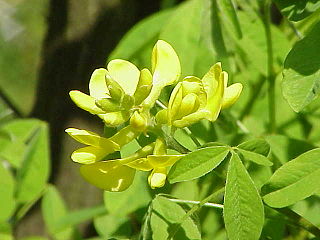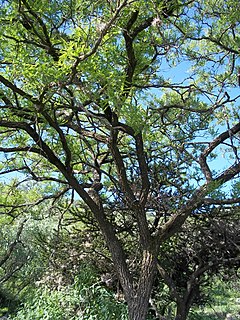
Laburnum, sometimes called golden chain or golden rain, is a genus of two species of small trees in the subfamily Faboideae of the pea family Fabaceae. The species are Laburnum anagyroides—common laburnum and Laburnum alpinum—alpine laburnum. They are native to the mountains of southern Europe from France to the Balkans.

Petteria ramentacea, commonly known as Dalmatian laburnum, is a species of flowering plants in the family Fabaceae. It belongs to the subfamily Faboideae. It is the only member of the genus Petteria.
Podocytisus caramanicus is a species of flowering plants in the family Fabaceae. It belongs to the subfamily Faboideae. It is the only member of the genus Podocytisus.
Dicraeopetalum is a genus of flowering plants in the family Fabaceae.
Neoharmsia is a genus of legume in the family Fabaceae.

Pericopsis is a genus of legume in the family Fabaceae.
Sakoanala is a genus of legume in the family Fabaceae.

Adenolobus is a genus of flowering plants in the legume family, Fabaceae. It belongs to the subfamily Cercidoideae.

Barklya is a genus of Australian trees in the legume family, Fabaceae. It belongs to the subfamily Cercidoideae. The sole species is Barklya syringifolia, commonly known as golden crown or golden glory. It grows in rainforest to 20 metres tall. Recorded from Queensland and New South Wales in rain forest. It is often used as an ornamental.

Adenocarpus is a genus of flowering plants in the family Fabaceae. It belongs to the subfamily Faboideae. The plants are broom-like shrubs with bright yellow flowers. The genus is native to Macaronesia, Portugal and southern Spain, and three species are endemic to the western Canary islands where they are known by the common name Codeso.

Calicotome is a genus of flowering plants in the family Fabaceae. It belongs to the subfamily Faboideae. It may be synonymous with Cytisus. All species of the genus are thorny shrubs. The ancient Greeks believed that tyrants in Hades were punished by being beaten with the thorny calycotomes.

Cytisophyllum sessilifolium is a species of flowering plants in the family, Fabaceae. It belongs to the subfamily Faboideae. It is the only member of the genus Cytisophyllum.

Erinacea is a small genus of flowering plants in the family Fabaceae.
Errazurizia (dunebroom) is a genus of flowering plants in the family Fabaceae. It belongs to the subfamily Faboideae.

Eysenhardtia is a genus of flowering plants in the family Fabaceae. It belongs to the subfamily Faboideae. Members of the genus are commonly known as kidneywoods.

Hesperolaburnum platycarpum is a species of flowering plants in the family Fabaceae. It belongs to the subfamily Faboideae. It is the only member of the genus Hesperolaburnum.

Parryella filifolia, the common dunebroom, is a species of flowering plants in the family Fabaceae. It belongs to the subfamily Faboideae. It is the only member of the genus Parryella. Its ashes were sometimes used by members of the Hopi tribe in the maize nixtamalization process and helped to retain the blue color of cornmeal used to make piki bread. The beans were also used as a remedy for toothaches.
Platycelyphium voense is a species of flowering plant in the family Fabaceae. It belongs to the subfamily Faboideae. It is the only member of the genus Platycelyphium.
Sellocharis paradoxa is a species of flowering plants in the family Fabaceae. It belongs to the subfamily Faboideae. It is native to Brazil and is the only member of the genus Sellocharis.
Spirotropis is a genus of flowering plants in the family Fabaceae. It belongs to the subfamily Faboideae.












